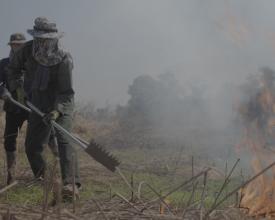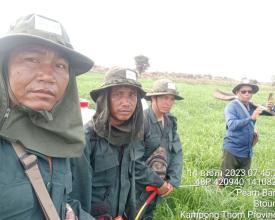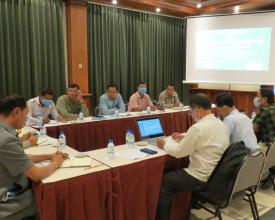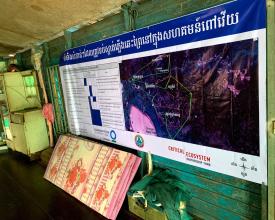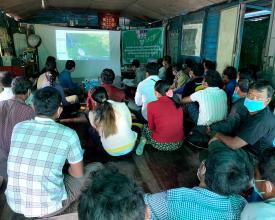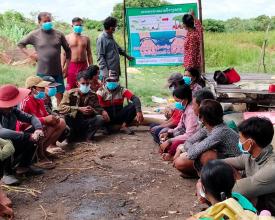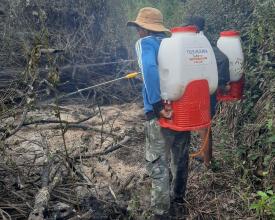Gestión comunitaria de los incendios forestales en el lago Tonle Sap

Los incendios forestales de la estación seca están destruyendo el bosque inundado del lago Tonle Sap y dañando su pesca. Y la falta de recursos hizo que las comunidades locales solo pudieran ver arder sus bosques. En 2019, Conservation International comenzó a trabajar con algunas comunidades pesqueras locales para hacer frente a los incendios forestales, proporcionándoles equipos básicos de extinción de incendios. Desde entonces, hemos desarrollado y estamos implementando Community Based Fire Management (CBFiM) en 17 comunidades. CBFiM es un enfoque comunitario integral para la gestión de incendios que tiene como objetivo prevenir y controlar los incendios y mejorar los medios de vida, la salud, la seguridad y conservar las tierras silvestres. El CBFiM se basa en el enfoque de las 5R:
- Revisión - identificar los problemas de los incendios y las opciones de cambio
- Reducción del riesgo - prevenir los incendios forestales.
- Preparación: prepararse para los incendios forestales.
- Respuesta: controlar y extinguir los incendios forestales.
- Recuperación: restaurar las zonas dañadas.
Estas comunidades cuentan ahora con los recursos y la confianza necesarios para prevenir y extinguir los incendios forestales en el marco del CBFiM.
Contexto
Défis à relever
Los bosques y matorrales inundados del lago Tonle Sap proporcionan un hábitat vital para los peces en la estación húmeda. Por tanto, su destrucción por incendios forestales reduce la abundancia y diversidad de peces y, por extensión, aumenta la inseguridad alimentaria entre las comunidades pesqueras del lago. Además, los incendios forestales se ven exacerbados por las estaciones secas, más largas y calurosas, provocadas por el cambio climático.
Aunque el CBFiM ha permitido a nuestras comunidades asociadas gestionar los incendios forestales, los retos pendientes incluyen la necesidad de
- formación avanzada en extinción de incendios;
- una mayor cooperación entre los equipos comunitarios de gestión de incendios y las autoridades locales; y
- mejores y más amplias campañas de concienciación.
Las comunidades también se enfrentan a los siguientes retos
- recursos financieros y humanos insuficientes para aplicar plenamente la CBFi;
- dificultad para implicar a los miembros más jóvenes de la comunidad en la gestión de los incendios forestales
- capacidad de gestión limitada de los equipos comunitarios de gestión de incendios; y
- dificultad para sofocar incendios de gran magnitud.
Ubicación
Procesar
Resumen del proceso
Los seis módulos son complementarios. El Bloque 1 - Compromiso de la comunidad y el gobierno establece el entorno propicio sobre el que se puede desarrollar el manejo comunitario de incendios e integrarlo en la planificación de la gestión comunitaria de los recursos naturales. Los bloques 2-6 forman parte de un ciclo de gestión adaptativa, repitiéndose ambos entre temporadas de incendios. Cada temporada de incendios se revisa (Bloque 2 - Revisión), lo que lleva a perfeccionar las estrategias de reducción de riesgos (Bloque 3 - Reducción de riesgos), la preparación para los incendios (Bloque 4 - Preparación), la extinción de cualquier incendio (Bloque 5 - Respuesta) y, al final de la temporada de incendios, las actividades de restauración (Bloque 6 - Restauración). Dentro de una temporada de incendios, el ciclo es pequeño y comprende los Bloques 3, 4 y 5.
Bloques de construcción
Participación de la Comunidad y el Gobierno
En primer lugar, identificamos una comunidad adecuada: una que esté amenazada por el fuego y tenga la voluntad de abordar el problema, y que idealmente cuente con un grupo comunitario establecido. En el lago Tonle Sap hemos trabajado con organizaciones pesqueras comunitarias, organizaciones comunitarias de áreas protegidas y aldeas para aplicar la gestión comunitaria de incendios. Contratar a una organización comunitaria formal con una estructura reconocida tiene varias ventajas, como un liderazgo comunitario reconocido, capacidad de gestión, recursos financieros como cuentas bancarias y reconocimiento por parte de las autoridades locales. En primer lugar, pedimos consejo a las autoridades gubernamentales locales sobre qué comunidades tienen la capacidad necesaria para participar en el CBFiM. A continuación, nos reunimos con los líderes de la comunidad para obtener su apoyo, antes de comprometernos con los Grupos de Ahorro de Mujeres que pueden proporcionar apoyo financiero. A partir de ahí, desarrollamos el equipo comunitario de gestión de incendios forestales, que debe estar integrado con las autoridades de la aldea y del municipio. El equipo comunitario de gestión de incendios forestales constituye la base del CBFiM.
Factores facilitadores
El éxito del establecimiento de CBFiM requiere
- Una comunidad comprometida con suficiente capacidad de gestión y el apoyo de las autoridades locales.
- La presencia de un grupo comunitario establecido, como una pesquería comunitaria o un área protegida comunitaria, aunque no es esencial, proporciona una estructura sobre la que puede adaptarse y construirse el manejo comunitario de las pesquerías.
- Un fuerte apoyo de las autoridades locales a nivel de aldea, comuna y distrito.
Lección aprendida
Al implicar a las comunidades y al Gobierno, hemos aprendido que:
- Dado que los líderes comunitarios, como los miembros de los comités de CFi y CPA, tienden a ser hombres mayores, animamos a diversificar el equipo comunitario de gestión de incendios forestales mediante la participación de mujeres y jóvenes.
- Las mujeres tienen un papel importante que desempeñar, ya que tradicionalmente gestionan las finanzas del hogar y pueden recordar al grupo de gestión de incendios la preparación para la temporada de incendios.
- Los miembros más jóvenes, aunque a menudo son difíciles de involucrar, aportan más energía al duro trabajo físico de la extinción de incendios.
- Conseguir el apoyo temprano del gobierno local ayuda a integrarlos en el plan de gestión comunitaria, que puede codificarse mediante el compromiso tanto a nivel de gobierno de distrito como provincial.
- El apoyo continuo del gobierno se mantiene a través de las frecuentes reuniones del Equipo de Coordinación Pesquera, que reúne a las comunidades y al gobierno para debatir cuestiones pesqueras, incluidos los incendios forestales.
Revisión - identificar los problemas de incendios y las opciones de cambio
Una vez creado el Equipo Comunitario de Gestión de Incendios Forestales, examinamos los problemas locales e identificamos opciones de cambio mediante una serie de métodos participativos. Nuestro objetivo es comprender cómo y por qué se inician los incendios en cada comunidad y los efectos positivos y negativos de los incendios provocados por diferentes motivos y en diferentes zonas. Recomendamos entrevistar a varias personas, incluidos los miembros del Equipo Comunitario de Gestión de Incendios Forestales, otros líderes y ancianos del pueblo, mujeres, jóvenes y autoridades locales.
Cuando comprendamos las causas y el impacto de los incendios forestales, realizaremos un mapeo comunitario para determinar espacialmente
- dónde es más probable que se produzcan incendios y por qué;
- posibles cortafuegos o líneas de control dentro del paisaje;
- la ubicación de las fuentes de agua
- ubicación de carreteras y caminos de acceso;
- zonas prioritarias para la protección (por ejemplo, bosques de gran valor y zonas de restauración); y
- la capacidad de los miembros de la comunidad local para controlar los incendios, tanto mediante medidas previas a la extinción como de extinción.
Estos mapas de incendios ayudaron a cada comunidad a aplicar medidas para prevenir, detectar y responder eficazmente a los incendios forestales.
Factores facilitadores
Para llevar a cabo con éxito la revisión de las cuestiones relacionadas con los incendios forestales es necesario
- Completar el Building Block 1 - Compromiso de la comunidad y el gobierno antes de emprender el proceso de revisión.
- Obtener una amplia gama de perspectivas sobre los incendios forestales dentro de cada comunidad, ya que las comunidades tendrán diferentes impulsores, respuestas y actitudes hacia los incendios forestales.
- Comprender por qué se producen los incendios forestales, sobre todo si se encienden para beneficiar a algunas personas, es crucial para gestionar sus efectos perjudiciales.
Lección aprendida
Al repasar las causas y consecuencias de los incendios forestales en el lago Tonle Sap aprendimos que:
- Los incendios forestales son provocados por el hombre, y la mayoría se prenden deliberadamente.
- El tiempo caluroso y seco es un factor importante de los incendios forestales. Y el viento es el principal factor de propagación del fuego.
- En las comunidades sin equipos de extinción de incendios, la lluvia es el principal factor de extinción.
- Recomendamos imprimir y exponer en un lugar destacado el plan anual CBFiM de cada comunidad para que sirva de recordatorio constante de la gestión de los incendios forestales y de las actividades planificadas.
Reducción de riesgos - prevención de incendios forestales
Con la reducción de riesgos trabajamos con las comunidades para prevenir los incendios forestales, centrando los recursos en sus causas subyacentes. La prevención es la medida de control más eficaz, ya que casi todos los incendios del Tonle Sap se deben a actividades humanas. Nuestras comunidades asociadas identificaron cuatro estrategias de reducción del riesgo de incendios forestales:
- Realizar múltiples sesiones de educación y concienciación sobre incendios forestales con los miembros de la comunidad local y los emigrantes estacionales.
- Instalar carteles informativos y de advertencia en zonas de alto riesgo de incendio y de alto valor de conservación.
- Realizar patrullas conjuntas de extinción de incendios con las autoridades locales y los funcionarios de la FiA.
- Identificar a los migrantes estacionales que visitan la zona gestionada por la comunidad para pescar y pastar búfalos. E informarles de que serán interrogados si se produce algún incendio en los alrededores de su zona de acampada temporal.
- Castigar a las personas que destruyan el bosque inundado aplicando la ley de pesca, que puede suponer entre 3 y 5 años de cárcel.
Factores facilitadores
Una reducción eficaz del riesgo requiere los siguientes factores:
- Los equipos comunitarios de gestión de incendios necesitan el apoyo de las autoridades locales para reducir el riesgo de incendios. Esto es necesario a la hora de acercarse y trabajar con inmigrantes estacionales que no son conocidos por los lugareños.
- El apoyo de las autoridades locales también es necesario cuando se trata de los aspectos legales de la reducción del riesgo de incendios, como la persecución de los infractores.
Lección aprendida
Entre las lecciones importantes en materia de reducción de riesgos figuran las siguientes
- La colocación de carteles -especialmente los que muestran las sanciones asociadas a encender fuego- en zonas de alto riesgo de incendio y lugares de gran valor disuade a la gente de encender fuego y promueve un comportamiento responsable. Recomendamos obtener la aprobación de las autoridades locales antes de utilizar estos carteles y pedirles consejo sobre su ubicación.
- Organizar varias sesiones de educación pública sobre incendios forestales al año. Las sesiones realizadas antes de la temporada de incendios pretenden cambiar el comportamiento de la gente y reducir el riesgo de incendios forestales. Las sesiones deben continuar durante la temporada de incendios para garantizar que la gente siga siendo consciente del riesgo de incendio forestal.
- Dado que los incendios forestales son provocados por las personas, el equipo de gestión de incendios forestales debería centrarse en educar a los miembros de la comunidad y a los emigrantes estacionales cuyo medio de vida depende de la pesca y, por tanto, del bosque inundado. Hay que implicar a los pescadores y ganaderos emigrantes, ya que se les considera responsables de haber provocado incendios en el pasado.
- Animar a las mujeres a participar en las sesiones de concienciación y educación, ya que son ellas quienes mejor pueden recordar a sus familiares y vecinos las causas y los peligros de los incendios forestales.
- Los miembros del equipo de gestión de incendios forestales deberían compartir sus datos de contacto con los pescadores emigrantes, para que puedan informarles si detectan algún incendio.
Preparación para los incendios forestales
A pesar de los mejores esfuerzos de reducción del riesgo, los incendios seguirán produciéndose y las comunidades asociadas deben estar preparadas para extinguirlos. Para estar preparados para apagar incendios, los grupos de CBFiM necesitan
- equipos de extinción de incendios de origen local en buen estado, incluida ropa de protección;
- formación en gestión de incendios; y
- alertas de incendios vía satélite en tiempo real.
Cada equipo comunitario de gestión de incendios forestales debe patrullar con frecuencia las zonas de alto riesgo durante la temporada de incendios. Esto les permite identificar y abordar los comportamientos de alto riesgo antes de que se inicie un incendio, controlar la carga de combustible y evaluar las rutas de acceso y la disponibilidad de agua en caso de incendio.
Factores facilitadores
Estar preparado para sofocar un incendio forestal requiere
- Un equipo comunitario de gestión de incendios forestales que funcione.
- Un sistema que detecte los incendios forestales y pueda alertar al equipo comunitario de gestión de incendios forestales.
- Se necesitan recursos externos para gestionar las alertas de incendios forestales, ya que debido a las limitaciones técnicas y a la capacidad de la comunidad no se pueden proporcionar directamente a los grupos comunitarios para que actúen.
Lección aprendida
Las lecciones para estar preparados para sofocar incendios forestales incluyen:
- Proporcionar a las comunidades ropa de protección fabricada con materiales naturales como el algodón, ya que el poliéster es inflamable y muy peligroso cuando se expone al fuego. El suministro de este equipo de seguridad es importante, ya que la ropa cotidiana de la mayoría de los miembros de la comunidad no es segura cuando se utiliza para sofocar incendios forestales.
- Nuestras comunidades asociadas informaron de que las alertas de incendios forestales de OroraTech enviadas por el personal del proyecto les avisaban con frecuencia de los incendios antes de que se observaran sobre el terreno. Este servicio es muy valioso para ellos, ya que pueden responder rápidamente, investigar y detener los incendios forestales antes de que se hagan grandes e incontrolables.
Recursos
Respuesta: control y extinción del incendio forestal
La aplicación de las acciones descritas anteriormente en materia de revisión, reducción de riesgos y preparación permite a las comunidades responder a los incendios forestales. Al recibir una alerta de incendio forestal, el Equipo Comunitario de Gestión de Incendios Forestales enviará a un miembro del equipo o pedirá a un miembro de la comunidad cercana que visite el lugar y evalúe la situación. Una vez confirmado que se trata de un incendio activo, el Equipo Comunitario de Gestión de Incendios Forestales determinará si es necesario extinguirlo y, en caso afirmativo, acudirá al lugar y lo extinguirá con el equipo adecuado. Si el incendio no amenaza a matorrales o bosques inundados, vigilará la situación.
La extinción eficaz de incendios requiere una planificación sobre el terreno y funciones y responsabilidades claras entre el Equipo de Gestión de Incendios Forestales. Es importante que el equipo elabore y acuerde un plan claro y seguro sobre cómo abordar y extinguir los incendios forestales y sobre el papel de cada miembro del equipo al respecto.
Es importante registrar los detalles de cada alerta de incendio, de cada incendio forestal confirmado y de las medidas adoptadas para hacer frente a cada incendio forestal, de modo que podamos aprender de nuestras experiencias y gestionar de forma adaptativa los incendios forestales en el futuro. Esta información es necesaria tanto para los componentes de revisión como de recuperación de las 5R.
Factores facilitadores
La extinción eficaz de incendios requiere
- Alerta temprana de un incendio forestal
- Un equipo de gestión de incendios formado y seguro de sí mismo que pueda sofocar el incendio forestal de forma segura con equipos locales en buen estado.
Lección aprendida
Entre las lecciones importantes en la respuesta a los incendios forestales se incluyen:
- Es preferible contar con equipos locales baratos que puedan adaptarse a la extinción de incendios forestales que con equipos especializados importados y caros. La experiencia de nuestros socios comunitarios con los equipos locales demostró su familiaridad con ellos, su eficacia en la extinción de incendios forestales y su facilidad de sustitución.
- Se pueden utilizar diversas herramientas para extinguir incendios forestales. Los miembros del Equipo de Gestión de Incendios Forestales de la Comunidad informaron de que la mayoría de las veces utilizaban herramientas manuales como rastrillos, azadas y cuchillas para eliminar el material inflamable y crear una barrera de tierra desnuda. También utilizaron mochilas pulverizadoras de agua para sofocar los incendios forestales.
- Aunque los equipos comunitarios de gestión de incendios forestales a menudo utilizaban agua para extinguir el fuego, a menudo no podían utilizar las bombas de agua y las mangueras, más grandes y pesadas, debido a la dificultad de acceder a los lugares y a la falta de acceso al agua (por ejemplo, lagos, arroyos o estanques).
- Una descripción clara del terreno del incendio ayudó a los equipos comunitarios de gestión de incendios forestales a decidir qué equipo desplegar. Por ejemplo, antes de desplegar una bomba de agua y mangueras es necesario tener acceso al lugar y un suministro de agua cercano.
Recuperación: restaurar las zonas dañadas
La recuperación tras un incendio forestal implica velar por el bienestar de la comunidad, reparar las infraestructuras y restaurar los paisajes dañados por el fuego. Los incendios forestales en el lago Tonle Sap tienen el mayor impacto en el entorno natural. Afortunadamente, los efectos directos sobre las personas y las infraestructuras son escasos. Por ello, la recuperación pasa por restaurar la vegetación dañada por el fuego. Para ello hay que determinar qué zonas se pueden restaurar y cuáles se dejan como están. Algunas zonas, como los senderos que atraviesan la espesa vegetación, se queman repetidamente para limpiar el jacinto de agua seco y la hierba para mantener el acceso, o se queman parcelas para despejar espacio para las redes de pesca. Cada comunidad debe decidir si estas zonas pueden restaurarse o si es mejor dejarlas intactas. Otras zonas pueden dejarse regenerar de forma natural o restaurarse activamente mediante técnicas como la regeneración natural asistida, el trasplante de plántulas de vivero o la siembra directa con especies autóctonas ( normalmente Barringtonia acutangula, Diospyros cambodiana y Combretum trifoliatum). Esto suele requerir recursos externos y la elaboración de planes de restauración con las comunidades locales.
Factores facilitadores
La recuperación tras un incendio forestal requiere
- Miembros de la comunidad con experiencia en diversas técnicas de restauración. En el lago Tonle Sap, lo más habitual es la propagación de semillas en un vivero y la plantación de plántulas en el lugar de restauración.
- Se necesita una fuente externa de financiación para apoyar las actividades de restauración, debido a la limitada capacidad financiera de las comunidades locales en el lago Tonle Sap.
Lección aprendida
Es esencial que la comunidad vaya ganando poco a poco confianza en la restauración para que pueda aumentar la superficie restaurada a lo largo de varios años y gestionar esa tierra restaurada.
Impactos
La aplicación de la Gestión Comunitaria de Incendios (CBFiM) en 17 comunidades del lago Tonle Sap ha permitido:
- Desarrollar y actualizar sus planes anuales de CBFiM;
- Colocar señales de advertencia de incendios;
- Informar a los aldeanos y a los emigrantes estacionales de su responsabilidad de no provocar incendios forestales.
- Informar de sus actividades a las autoridades locales competentes.
Hemos suministrado a las comunidades equipos de extinción de incendios disponibles localmente y hemos proporcionado a cada comunidad alertas de incendios forestales en tiempo real de OroraTech(https://ororatech.com/wildfire-service/). Esto les permitió responder rápidamente a los incendios forestales. Desde 2019 han respondido y sofocado veintidós incendios forestales que, de otro modo, habrían ardido sin control.
Concedimos a once Grupos de Ahorro de Mujeres fondos CBFiM de 500 a 1.000 dólares que han generado 3.230 dólares en intereses. Dinero que sus socios de CFi pueden utilizar para la gestión de incendios. Proporcionamos formación experta en gestión de incendios a setenta y ocho personas de grupos comunitarios y organismos gubernamentales locales, lo que aumentó su confianza en la gestión de incendios forestales.
Beneficiarios
Los miembros de las comunidades pesqueras se benefician de una mejor gestión de los incendios. La reducción del impacto de los incendios en el hábitat de las llanuras aluviales beneficia a unas 300 especies de peces y a numerosas aves, mamíferos y reptiles amenazados por la Lista Roja de la UICN.
Objetivos de Desarrollo Sostenible
Historia
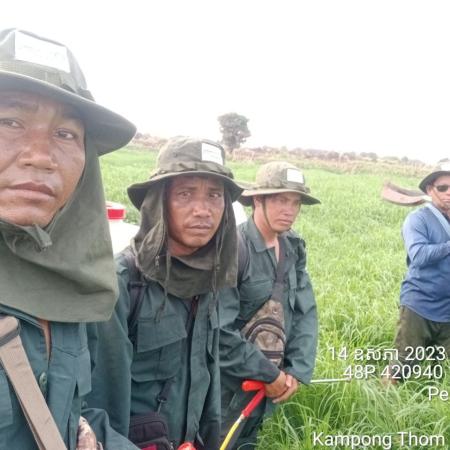
Nuestros socios comunitarios están entusiasmados con la idea de controlar los incendios forestales, que "son peores que talar el bosque inundado", según el Sr. Pen Sokhom, jefe del CFi de Kampong Prak. Mientras que los miembros del CFi de Doun Sdaeung señalaron que "la ceniza y los escombros que quedan tras un incendio hacen que el agua se contamine y no sea apta para los peces". Todos los grupos comunitarios consideraron extremadamente útil el sistema de detección de OroraTech con alertas en tiempo real de incendios forestales, que proporciona notificaciones sobre incendios de los que, de otro modo, podrían no ser conscientes, con detalles sobre la ubicación y la hora de los mismos. Los miembros de las pesquerías comunitarias de Kampong Khnease y Ou Ta Prok declararon que antes del CBFiM, cuando se enfrentaban a un incendio, sólo podían intentar vencer las llamas utilizando ramas cortadas de los árboles, lo que nunca tenía éxito. La CBFiM les ha proporcionado el equipo y los conocimientos necesarios para controlar los incendios forestales y, lo que es más importante, les ha dado la confianza necesaria para organizarse en equipo y sofocarlos con seguridad.

